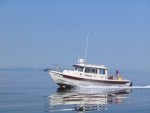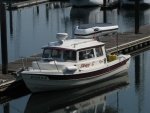thataway
Well-known member
- Joined
- Nov 2, 2003
- Messages
- 21,699
- Reaction score
- 70
- C Dory Year
- 2007
- C Dory Model
- 25 Cruiser
- Hull Identification Number
- DOR25652A707
- Vessel Name
- thataway
A day ago there was another Florida boat crashed reported---that that this is unusual, but what stands out here, is that it was captured on video, as the boat crashed into the sea wall of a Coast Guard Station. There is speculation that there was a mechanical steering failure of medical problem.
I have witnessed incidents of this type happen several times in my life where there was mechanical failure of a steering system. We all need to remember that failures, of both steering and throttle can happen.
Don't run at a fast speed where such a failure could cause an accident (either running aground, or hitting another boat), be aware of how to stop the boat if this happens (avoid panic, and chop the throttle/ cut off ignition or fuel/ be able to rapidly devise some way of diverting the course of the boat, necessary). So here is the puzzle, what would have you done if you had been at the helm of the boat?--assuming it was mechanical failure?
http://www.local10.com/news/boat-crashe ... e/31915998
I have witnessed incidents of this type happen several times in my life where there was mechanical failure of a steering system. We all need to remember that failures, of both steering and throttle can happen.
Don't run at a fast speed where such a failure could cause an accident (either running aground, or hitting another boat), be aware of how to stop the boat if this happens (avoid panic, and chop the throttle/ cut off ignition or fuel/ be able to rapidly devise some way of diverting the course of the boat, necessary). So here is the puzzle, what would have you done if you had been at the helm of the boat?--assuming it was mechanical failure?
http://www.local10.com/news/boat-crashe ... e/31915998



